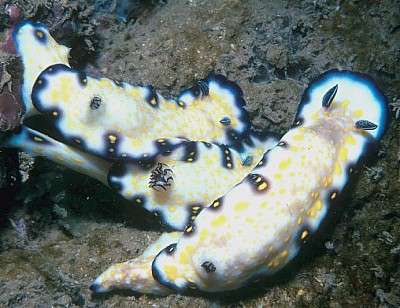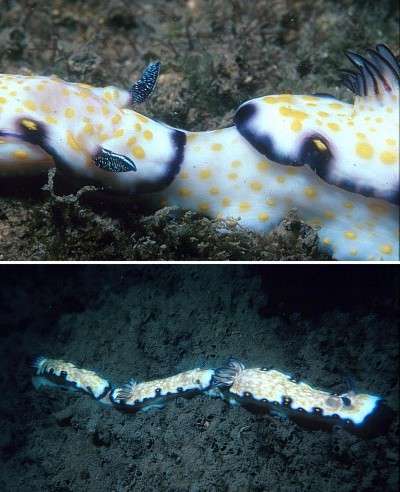Trailing in Risbecia imperialis
August 17, 1999
From: Scott Johnson


Hi Bill,
In the late 70s, when I was doing my opisthobranch work in Hawaii, one of my sites supported a good sized population of Risbecia imperialis. The site was along one side of a boat channel that led into Ala Wai Yacht Harbor in Honolulu. The area was pretty mucky and who knows what was in the water--the channel was the sole outflow to the sea from the Ala Wai Canal, into which drains runoff from rain that falls into several valleys above Honolulu. But it supported lots of various kinds of filter feeders, and several common species of nudibranchs. I could without much trouble count 50 or more R. imperialis on a single dive. I haven't been back for a while, but in recent years, John Hoover, author of the recently published Hawaii's Sea Creatures, has been diving the site. The R. imperialis are no longer there. Now the most common species is Tambja morosa, a species I never saw there in the late 70s.
One interesting feature of the Hawaiian Risbecia imperialis is that individuals can be identified by color pattern. The lateral margins have variable numbers of dark blue-black finger-shaped blotches extending towards the middorsum, and these blotches bear between 0 and about five orange spots. By recording the spots per blotch along each side, you could develop a code for a species and recognize them from one dive to the next. No doubt these spots would change over enough time, but it worked quite well in the short term. For several months, Hans Bertsch and I dove there regularly and recorded where and how we saw the individuals we recognized.
Individuals were nearly always paired, but sometimes in threes or even fours. They were either feeding on a blue-gray sponge I think is a species of Dysidea, or were actively moving. When moving, they always showed the trailing or queuing behavior. One interesting result we found was that the animals changed partners frequently. I watched it happen one day. Two pairs were moving along, each pair showing its own trailing behavior. While I was there, the two pair collided. After a confused moment, they rejoined in a queue of all four individuals. A few minutes later, the queue broke in half and the two pair went off in their own directions--having traded partners in the confusion. Apparently not very discriminating in their mates.
UPPER PHOTO: Three feeding on silt encrusted sponge.
MIDDLE: Close-up of a queue
LOWER: Three trailing across silt-covered bottom.
On a slightly different subject, do the specimens of this species (or of "godeffroyana") in the far western Pacific always match the coloration of those you have figured? Those I found in the Solomons were much like yours. I had always thought the coloration of the Hawaiian ones was unique until I found a single specimen of R. imperialis in the Marshalls; it looks just like a Hawaiian one.
Scott
johnson@kmr.ll.mit.edu
Johnson, S., 1999 (Aug 17) Trailing in Risbecia imperialis. [Message in] Sea Slug Forum. Australian Museum, Sydney. Available from http://www.seaslugforum.net/find/1196Dear Scott,
Thanks for these photos and the information. Looking at your Hawaiian animals again, I must say I wonder if we are premature in considering R. godeffroyana and R. imperialis to be synonyms. Certainly most of the western Pacific animals I have seen alive, or in photos, match the photos at the Top of the Page, but there are some which don't have the pinkish central region and have only large yellow spots, somewhat like the Hawaiian (and Marshall Ids) colour pattern. But looking again at your photos, I wonder if they are the same. I'll try and find a good photo to post. If anyone has evidence of either colour form outside their 'normal' geographic ranges we would love to hear of it.
Bill Rudman.
Related messages
-
Re: Risbecia imperialis from Hawaii
From: Cory Pittman, January 9, 2007 -
Risbecia imperialis from Hawaii
From: Aidan Hampson, January 5, 2007 -
Original illustration of Doris prismatica var imperialis Pease 1860
From: Bill Rudman, March 7, 2005 -
Original illustration of Doris propinquata Pease 1860
From: Bill Rudman, March 7, 2005
